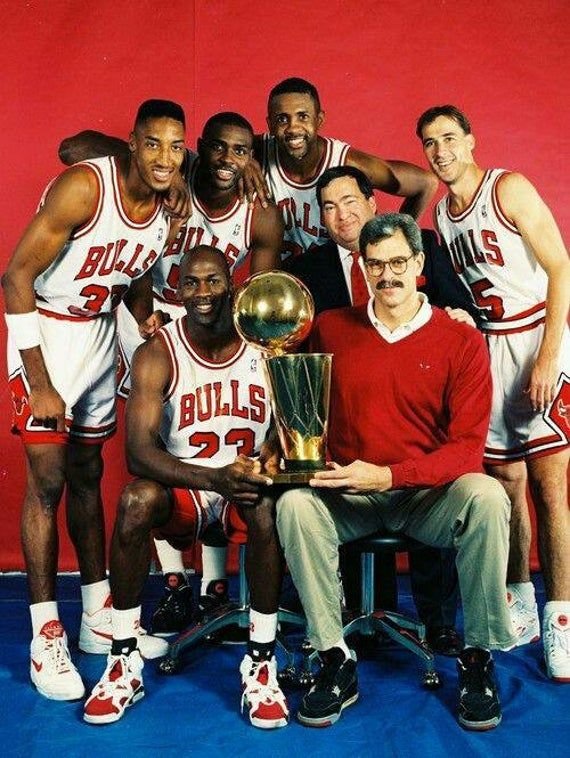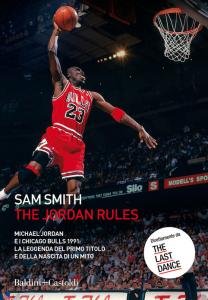The Jordan Rules, il miracolo dei Bulls
La nuova vita editoriale di uno dei libri sulla pallacanestro più belli di sempre, quello di Sam Smith sui Chicago Bulls 1990-91...
2 Maggio 2021
di Stefano Olivari

Uno dei migliori libri sulla pallacanestro mai scritti è senza dubbio The Jordan Rules, di Sam Smith, che racconta la stagione 1990-91 dei Chicago Bulls, quella del primo anello dell’era Michael Jordan. Un miracolo non per il valore dei giocatori, anche se molti addetti ai lavori NBA ritenevano quei Bulls troppo leggeri per la durezza dei playoff, ma perché raramente un trofeo così importante è stato vinto da un gruppo di giocatori così spaccato.
Libro uscito nel 1992, straletto da tutti gli appassionati già quasi tre decenni fa ma che potrebbe avere una seconda vita editoriale dopo il successo di The Last Dance su Netflix, peraltro riguardante la stagione finale di quel grande ciclo. Ed infatti è stato rieditato l’anno scorso, uscendo anche tradotto in italiano da Baldini+Castoldi, con una interessantissima prefazione di Smith alla luce di tutto quanto è accaduto dal 1991 ad oggi e della considerazione di quei Bulls filtrata dalla serie televisiva. 20 pagine davvero molto interessanti, riflessioni acute sul rapporto fra campioni e giornalisti.
Gli Stati Uniti hanno una grande tradizione di libri sportivi critici, avendo a disposizione grazie alla diffusione della lingua più tipi di pubblico: quello che vuole l’agiografia (il capitano non si discute, si ama), quello che vuole la distruzione del personaggio o della squadra e quello che essendo molto interessato ad un argomento vuole leggerne in maniera sia coinvolta (e quindi coinvolgente) sia critica. L’opera di Smith, ai tempi inviato al seguito della squadra per il Chicago Tribune, fa parte della terza categoria e non staremo a fare il riassunto di fatti che tutti gli interessati già conoscono, dalla feroce rivalità con i Pistons di Isiah Thomas e dei Bad Boys alle grandi sfide nei playoff con i durissimi Knicks di Ewing e Oakley, con i Sixers di Charles Barkley, con gli odiati Pistons e in finale contro i Lakers di Magic Johnson, Worthy e i resti dello squadrone allo Showtime, con il sangue nuovo di Vlade Divac.
Della rilettura di The Jordan Rules ci hanno colpito due cose. La prima è che quello che all’epoca ci sembrava un libro molto duro verso Jordan in realtà non lo è: evidenzia sì i tratti ossessivi della personalità di MJ e il suo inesistente rapporto con compagni, spesso oggetto di cattiverie fra il motivazionale e il gratuito, ma anche la sua onestà di fondo e il suo fare sempre sul serio, in una NBA dove molto era (ed è) finto. Jordan era convinto che la fonte del libro di Smith, davvero molto preciso nel citare frasi dette all’interno dello spogliatoio (diversamente sarebbe stato sfondato di querele), fosse Horace Grant ma molti episodi citati sono con Grant assente e quindi le fonti sono diverse. Di certo con gli occhi di oggi avrà visto in luce diversa un libro che dà di lui un’immagine umana, diversa da quella monolitica di The Last Dance e da quella che di lui hanno molti suoi fan.
La seconda cosa che ci ha colpito, con gli occhi di oggi, è la bravura di Smith nel raccontare Phil Jackson al di là della retorica sull’allenatore Zen che piace un po’ a tutti noi. Jackson è una persona di grande cultura, ma anche un ex giocatore NBA del genere gregario che gioca sporco, con una infanzia particolarissima: solo uno come lui, con la sua abilità nel manipolare le persone, anche quelle con autostima assurda come Jordan, poteva far remare nella stessa direzione uno spogliatoio spaccato, pieno di risentimenti personali e rivendicazioni salariali, da Pippen a John Paxson, da Cartwright a Grant. Tutti fra l’altro uniti dall’antipatia verso il gm Jerry Krause e verso il suo obbiettivo supremo Toni Kukoc, che sarebbe arrivato solo nel 1993 (parentesi: anche Kukoc un mostro, per essere riuscito a non essere distrutto da questo ambiente). A chi non l’ha letto diciamo che l’espressione The Jordan Rules ha un doppio significato: i trucchi e le strategie messi in atto dai Pistons per limitare il fuoriclasse avversario, ma anche le regole non scritte di una squadra che aveva Michael Jordan. Una grande storia, raccontata benissimo da un giornalista vero. Perché anche a Chicago ci saranno stati giornalisti timorosi di perdere il cinque alto di MJ, la maglietta autografata o l’accredito.
One of the best books on basketball ever written is undoubtedly The Jordan Rules, by Sam Smith, which recounts the 1990-91 season of the Chicago Bulls, the one of the first ring of the Michael Jordan era. It was a miracle, not because of the value of the players, even if many NBA insiders thought the Bulls were too light for the toughness of the playoffs, but because rarely has such an important trophy been won by such a divided group of players.
The book came out in 1992 and was rejected by all fans almost three decades ago, but it could have a second life after the success of The Last Dance on Netflix, which is about the final season of that great cycle. And in fact it was reissued last year, also coming out translated into Italian by Baldini+Castoldi, with a very interesting preface by Smith in light of everything that has happened since 1991 and the consideration of those Bulls filtered by the television series. 20 very interesting pages, acute reflections on the relationship between champions and journalists.
The United States has a great tradition of critical sports books, having at its disposal, thanks to the diffusion of the language, several types of public: those who want hagiography (the captain is not to be discussed, he is loved), those who want the destruction of the character or the team, and those who, being very interested in a subject, want to read about it in a way that is both involved (and therefore engaging) and critical. The work of Smith, at the time a correspondent following the team for the Chicago Tribune, belongs to the third category, and we won’t go into a summary of facts that all those interested already know, from the fierce rivalry with the Pistons of Isiah Thomas and the Bad Boys to the great challenges in the playoffs with the tough Knicks of Ewing and Oakley, with the Sixers of Charles Barkley, with the hated Pistons and in the finals against the Lakers of Magic Johnson, Worthy and the remains of the squadron at Showtime, with the new blood of Vlade Divac.
Two things struck us about the re-reading of The Jordan Rules. The first is that what at the time seemed to be a book very hard on Jordan is actually not: it highlights the obsessive traits of MJ’s personality and his non-existent relationship with his teammates, often the object of nastiness between motivational and gratuitous, but also his basic honesty and his always being serious, in an NBA where much was (and is) fake. Jordan was convinced that the source of Smith’s book, which is very precise in quoting phrases said inside the locker room (otherwise he would have been pelted with lawsuits), was Horace Grant, but many episodes cited are with Grant absent and therefore the sources are different. Certainly with today’s eyes he will have seen a book that gives a human image of him in a different light, different from the monolithic one of The Last Dance and from the one that many of his fans have of him.
The second thing that struck us, with today’s eyes, is Smith’s ability to tell the story of Phil Jackson beyond the rhetoric about the Zen coach that we all like. Jackson is a person of great culture, but also a former NBA player of the gregario genre who plays dirty, with a very particular childhood: only someone like him, with his ability to manipulate people, even those with absurd self-esteem like Jordan, could make a divided locker room, full of personal resentments and salary claims, from Pippen to John Paxson, from Cartwright to Grant, all row in the same direction. All of them, among other things, united by their antipathy towards GM Jerry Krause and his supreme objective Toni Kukoc, who would arrive only in 1993 (by the way: Kukoc was also a monster, because he managed not to be destroyed by this environment). To those who haven’t read it, let’s say that the expression The Jordan Rules has a double meaning: the tricks and strategies implemented by the Pistons to limit the opposing star, but also the unwritten rules of a team that had Michael Jordan. A great story, well told by a real journalist. Because even in Chicago there must have been journalists afraid of losing MJ’s high-five, autographed jersey or accreditation.
Translated with www.DeepL.com/Translator (free version)






Commenti Recenti